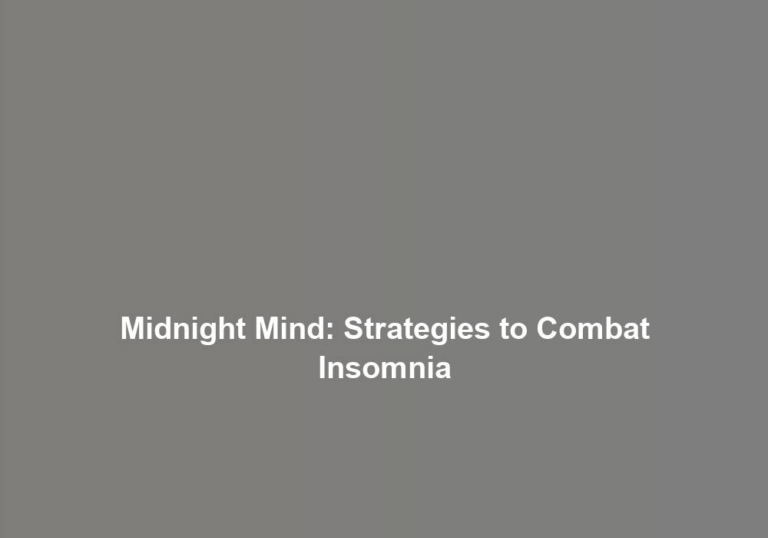Nightly Zen: The Art of Sleep Hygiene
As the old saying goes, G??sleep tight, donG??t let the bedbugs bite.G?? But achieving a restful nightG??s sleep goes beyond simply tucking yourself in. Have you ever considered the art of sleep hygiene and its impact on your overall well-being? ThereG??s more to it than just closing your eyes and hoping for the best. This discussion will shed light on the various techniques and practices that can help you cultivate a state of nightly zen, leading to improved quality of sleep and a more rejuvenated you.
Understanding Sleep Hygiene
Understanding sleep hygiene means establishing healthy habits and routines to promote better sleep quality. One of the key components of sleep hygiene is maintaining a consistent sleep schedule. This involves going to bed and waking up at the same time every day, even on weekends. By sticking to a regular sleep routine, your bodyG??s internal clock will align, and youG??ll find it easier to fall asleep and wake up feeling refreshed.
Another crucial aspect of sleep hygiene is your bedroom setup. Creating a sleep-conducive environment can significantly impact the quality of your rest. Consider factors such as the comfort of your mattress and pillows, the room temperature, and the level of noise and light. ItG??s essential to make your bedroom a peaceful and relaxing space, free from distractions that could disrupt your sleep.
When it comes to your sleep schedule, try to prioritize consistency. Set a specific bedtime and wake-up time that allows for at least 7-9 hours of sleep, based on your individual needs. This regularity helps regulate your bodyG??s internal clock, making it easier to fall asleep and wake up naturally. Additionally, pay attention to your bedroom setup. Keep your sleeping environment dark, quiet, and cool to promote better sleep quality. Your bedroom should be a sanctuary for rest and relaxation, allowing you to unwind and prepare for a restful nightG??s sleep.
Creating a Relaxing Sleep Environment
To create a relaxing sleep environment, focus on minimizing distractions and optimizing comfort in your bedroom. Your bedroom decor and ambient lighting play a crucial role in setting the right mood for a restful nightG??s sleep. Here are some tips to help you create the perfect sleep environment:
-
Declutter and Simplify: Keep your bedroom free from clutter and unnecessary items. A tidy space can help ease your mind and promote relaxation. Consider using storage solutions to keep things organized and out of sight.
-
Comfortable Bedding: Invest in high-quality, comfortable bedding that suits your preferences. Whether itG??s soft cotton sheets, a cozy comforter, or supportive pillows, prioritize your physical comfort.
-
Soft Lighting: Opt for soft, warm lighting in your bedroom to create a calming atmosphere. Consider using lamps with dimmer switches or installing warm-toned light bulbs to achieve a soothing ambiance.
-
Personal Touches: Incorporate personal touches into your bedroom decor to make the space feel uniquely yours. Whether itG??s artwork, photographs, or sentimental items, surrounding yourself with familiar and comforting elements can contribute to a sense of belonging and relaxation.
Establishing a Consistent Bedtime Routine
After creating a relaxing sleep environment by minimizing distractions and optimizing comfort in your bedroom, itG??s essential to establish a consistent bedtime routine to signal to your body that itG??s time to wind down and prepare for rest. A consistent schedule is crucial for regulating your bodyG??s internal clock, helping you fall asleep more easily and wake up feeling refreshed. To achieve this, aim to go to bed and wake up at the same time every day, even on weekends. By doing so, you help set your bodyG??s natural sleep-wake cycle.
In addition to a consistent schedule, winding down techniques can greatly aid in preparing your mind and body for sleep. Consider incorporating activities such as gentle yoga, reading a book, or practicing deep breathing exercises into your bedtime routine. Engaging in these calming activities can help relax your mind, reduce stress, and signal to your body that itG??s time to unwind.
Furthermore, establishing a consistent pre-sleep routine can also involve minimizing exposure to screens and bright lights at least an hour before bed. The blue light emitted by electronic devices can interfere with your bodyG??s production of melatonin, a hormone that regulates sleep. Instead, opt for activities that promote relaxation and prepare you for a restful night.
Managing Screen Time and Stimulants
Consider reducing your screen time and avoiding stimulants in the evening to support a restful nightG??s sleep. Managing screen time and stimulants can significantly impact the quality of your sleep. Here are some tips to help you create a calming environment before bedtime:
-
Limiting Caffeine: ItG??s important to be mindful of your caffeine intake, especially in the afternoon and evening. Caffeine is a stimulant that can disrupt your sleep, so try to avoid consuming caffeinated beverages or foods close to bedtime. Opt for decaffeinated options or soothing herbal teas instead.
-
Reducing Blue Light: Electronic devices emit blue light, which can interfere with your bodyG??s natural sleep-wake cycle. Consider reducing your exposure to screens at least an hour before bed. You can also use blue light filters or special glasses to minimize the impact of screens on your sleep.
-
Creating a Tech-Free Zone: Designate your bedroom as a tech-free zone to promote relaxation and better sleep. Keep electronic devices such as smartphones, tablets, and laptops out of the bedroom to minimize distractions and blue light exposure.
-
Establishing Wind-Down Activities: Engage in calming activities in the evening to signal to your body that itG??s time to wind down. This could include reading a book, practicing gentle yoga, or listening to soothing music to prepare your mind and body for a restful nightG??s sleep.
Incorporating Mindfulness and Relaxation Techniques
Incorporate mindfulness and relaxation techniques into your nightly routine to promote a sense of calm and prepare your mind and body for a restful nightG??s sleep. Mindful breathing is a powerful tool to help you unwind and release the stress of the day. Take a few minutes to focus on your breath, inhaling deeply through your nose and exhaling slowly through your mouth. Notice the sensation of the air filling your lungs and the gentle rise and fall of your chest. This simple practice can help quiet your mind and signal to your body that itG??s time to relax.
Progressive muscle relaxation is another effective technique to incorporate into your bedtime routine. Starting with your toes, tense each muscle group for a few seconds and then release, working your way up through your body. This method can help release physical tension and promote a sense of overall relaxation. As you engage in progressive muscle relaxation, visualize the stress leaving your body with each exhalation, leaving you feeling lighter and more at ease.
Conclusion
So, remember to prioritize your nightly zen and practice good sleep hygiene. Set the stage for a relaxing sleep environment, stick to a consistent bedtime routine, and limit screen time and stimulants. Incorporate mindfulness and relaxation techniques for a truly blissful nightG??s sleep. YouG??ll feel so refreshed and rejuvenated, itG??ll be like waking up to a symphony of singing birds and a rainbow of butterflies fluttering around your room. Good night and sweet dreams!







